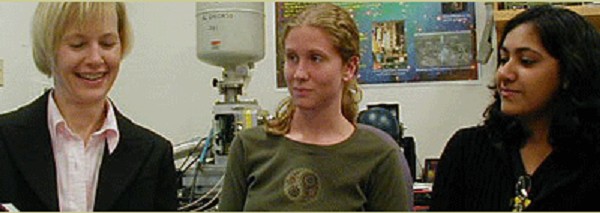It’s International Women’s Day, and people seem to find it easier to support girls than women.
I’ve noticed this as a Woman In Science, this eagerness to encourage girls into science with no concern as to what might happen to them as they, inevitably, become Women In Science. Isn’t that what we want for them, to evade the leaks in the pipeline and become role models that future girls can look up to? Don’t we want girls to become Women Who Have It All?
And yet, it’s easier to support girls than women – girls aren’t threatening. Girls aren’t competition. How else to explain the fact that, at this stage in my career, I face more sexism than I ever have before? I went off to college in 2001, at the ripe old age of 16, and you’d think things would have gotten better since then.
But when you’re part of a student cohort, or even a postdoctoral researcher or senior postdoc, you’re classed with other researchers at your level. As a PI on the other hand, running a research group, teaching undergrads, applying for funding, suddenly I am being treated worse than at any previous time in my career. Sure, it’s a demanding job, but I can’t help but notice the female junior academics around me getting saddled with heavier workloads and negative attitudes about their gender that male academics don’t have to deal with. And it doesn’t make my job easier when I can’t go to a conference without being asked ‘who do you work for?’
I have to admit I thought that as a society we’d be over this by now. Naïve student Jessamyn would have assumed there would be no need for gender quotas, in a place as progressive as a university setting, in the year 2019. Lecturer Jessamyn grimly admits that we still need them, and we have a long way to go before we are truly including everyone in higher education, and in science. Science is for everyone, regardless of gender, race, class, sexuality, or background, but it’s a lot of work to make that happen. Initiatives like the Athena SWAN and IOP Juno awards are a step in the right direction, and I’m glad to see my own institution pursuing them, but I think of them as being like the Bechdel Test – a necessary minimum, but not nearly enough to ensure true inclusion. We need to make sure that everyone is part of the story, not just the usual suspects.
Sometimes I find this tough going. I work in physics, a field with a pretty bad diversity problem, and I am used to being the only woman in the room. I wish I didn’t have so much experience being put down or disrespected, and while it may me a minority of physicists who act this way, a few consistent bad experiences can really change the environment. I sometimes wonder about the ethics of encouraging young girls into physics, having had the experiences I have: am I shepherding them into a place where they won’t be valued?

But you know, when I was an undergraduate at the cusp of either leaving physics or doubling down and pursuing a graduate education, I was lucky to end up working for an amazing physicist who I looked up to. She was an inspiration, a wonderful and supportive supervisor, and a role model whether she intended to be or not. In fact she still is – her name is Dr. Natalie Roe, and she is now the Physics Director of Lawrence Berkeley National Lab. I’m sure she faced adversity in her career, and had experiences that differed from her male colleagues, but when I looked at her as a student I saw an incredible scientist and person, who I wanted to emulate. She paved a road for me into physics, and probably for many other young women who she mentored.
Culture change is slow, and frustrating, and in fighting injustice we often feel like we are far behind where we want to be. But I am grateful for everyone who’s pushed for change, and I hope that we can all keep paying this forward, to make science the kind of place where every girl, and every woman, is truly welcome.

Pingback: ‘I sometimes wonder about the ethics of encouraging young girls into physics’ – MasMaz